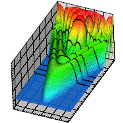Department of Physics and Astronomy: Publications and Other Research

Anthony F. Starace Publications
Document Type
Article
Date of this Version
12-19-2002
Abstract
The partial wave analysis of two-photon free–free (bremsstrahlung) electron transition cross sections during scattering by a static potential U(r), as well as by an atom with a nonzero angular momentum, is carried out. The dipole interaction with radiation is taken into account in the second order of perturbation theory for the general case of elliptic polarization of photons. The polarization and angular dependences of the twophoton potential scattering amplitude is presented as a combination of the scalar product of electron momenta and photon polarization vectors and five atomic parameters containing Legendre polynomials of the scattering angle as well as radial matrix elements depending on the initial (E) and final (E') electron energies. The results are applicable both for spontaneous double bremsstrahlung at nonrelativistic energies and for induced absorption and emission in the field of a light wave. Specific polarization effects (circular and elliptic dichroism) are analyzed for two-photon bremsstrahlung processes associated with the interference of the Hermite and anti- Hermite parts of the amplitude and depending on the sign of photon helicity. The limiting cases of high and low photon frequencies are investigated analytically, and the asymptotic forms of radial matrix elements and amplitudes for the general form of the U(r) potential are determined. Closed analytic expressions are derived for the radial matrix elements of the Coulomb potential in the form of integrals of hypergeometric function, and singularities are singled out in explicit form for E' → E. The methods of approximate calculation of the radial matrix elements are discussed, and the results of their exact numerical calculation, as well as angular distributions and the cross sections of induced one- and two-photon emission and absorption, are given for the case of the Coulomb potential. The numerical results show that dichroism effects are quite accessible for experimental observations.


Comments
Published in Journal of Experimental and Theoretical Physics, Vol. 95, No. 6, 2002, pp. 1006–1032. Copyright © 2002 MAIK “Nauka/Interperiodica”; http://www.maik.ru
Used by permission.
Translated from Zhurnal Éksperimental’noĭ i Teoreticheskoĭ Fiziki, Vol. 122, No. 6, 2002, pp. 1168–1197. Original Russian Text Copyright © 2002 by Krylovetskiĭ, Manakov, Marmo, & Starace.